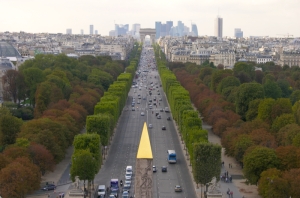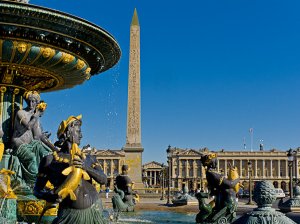This journey will be a very interesting day. It will be more pleasant if there is nice weather because you will have the chance to walk in Paris and spend all your time outside!
The morning: The Arc de Triomphe
After having a good breakfast, we have decided to show you the Arc de Triomphe on the Place Charles de Gaulle ( Place de l’Etoile).
A little bit of history …
The construction of the “Triumphal Arch” started in 1806 and finished in 1836 and was designed by Jean Chalgrin.
The Emperor Napoleon asked for the construction after the victory at Austerlitz in 1806: it honours those who fought and died for France. The names of all French victories and generals are written on its inner and outer surfaces.
The other important thing to know about the Arc de Triomphe is that this is the place where the Tomb of the Unknown Soldier from World War I lies. On this tomb, there is an eternal flame: it burns in memory of the dead who were never identified in both world wars.
Now, every 11 November stands a ceremony on the anniversary of the armistice signed between France and Germany in 1918.
Practical information
The first thing you must do is to walk beneath the vault. You will see the architecture and the tomb. After that, we recommand strongly to climb upstairs to see the amazing view: the Champs-Elysees Avenue with the Place de la Concorde in the background. You will also see the Place de l’Etoile and understand the origin its name.
The Arc de Triomphe opens at 10 a.m and closes at 11 p.m
The visit costs 9.50 euros and is free for students under 18 years.
The afternoon : The Champs-Elysees Avenue
Everybody knows it: it’s one of the most famous streets in the world and you can’t escape of going down this avenue.
A little bit of history …
At her construction this avenue was only gardens. The avenue was transformed by the landscape architect André Le Nôtre in 1667 according to the wishes of Louis XIV. It was commissioned in 1670 and was then called “Grand Cours” (the Great Course) and wouldn’t take the name of Champs-Élysées until 1709.
Only a few people live on this avenue because of the very high rents.
It’s on this avenue that stands on 14 July the largest military parade of Europe! During the year, each time there is something to celebrate, you can be sure to find a lot of people on this beautiful avenue.
What to do?
The avenue is also very famous for the shopping: there are very expensive stores like Cartier or Louis Vuitton, but there are also cheaper brands like Zara, H&M or Abercrombie & Fitch. Don’t be shy and don’t hesitate to enter in every store : some of them are really beautiful.
Where to lunch or have a drink?
Because you will spend a good part of your journey strolling in front of the shopwindows, you will probably become hungry.
Don’t worry, everything is here!
If you are a very rich person, you can go to the Fouquet’s, a very famous restaurant of the Champs-Elysees. But you don’t have to pay a fortune to eat on the avenue: There are a lot of little stores like “Pomme de Pain” or “La Brioche Dorée” which offer a lot of little meals or sandwichs, whis tables and chairs to make a break.
Don’t miss the store La Duree, a very famous brand of macarons. You will be able to taste a lot of cake with a delicious coffee.
To have a drink, there are a lot of bars on the avenue, some very expensive (like the George IV), but you will also find places like Starbucks.
The end of the day: the bottom of the Champs-Elysées and the Place de la Concorde
At the very end of the avenue, the stores will dissappear and you will find beautiful places with a lot of gardens, like The Grand Palais. If you walk a little bit, you will arrive at the Place de la Concorde.
A little bit of history …
The place measures 8.64 hectares (21.3 acres) in area: it is the largest square in the French capital. The Place was designed by Ange-Jacques Gabriel in 1755 and was called “Place Louis XV” (the name of the king at that time).
During the French Revolution, the statue of Louis XV was torn down and the area renamed “Place de la Révolution”. It was here that King Louis XVI was executed on 21 January 1793.
In 1795, the square was renamed “Place de la Concorde” as a gesture of reconciliation after the French Revolution.
The center of the Place is occupied by a giant Egyptian obelisk with hieroglyphics. It is one of two the Egyptian government gave to the French in the 19th century. The other one stayed in Egypt : It was giving back to Egyptians in the 1990s by President François Mitterrand.
Where to have dinner?
If you want to have a very expensive dinner, you can go to the Crillon, a beautiful hotel on the Place de la Concorde.
But we propose you the restaurant Fuxia, who stands rue Saint Honoré, a delicious place where you can eat pasta!
We hope you enjoyed your day, and see you tomorrow !
Alice Ecourtemer.



